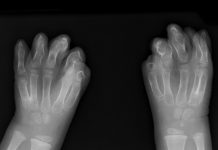Fibromyalgia is a physical disorder that is characterized as widespread pain throughout the body. People who suffer from fibromyalgia often complain of fatigue and pain.
There is no simple test that will reveal if you suffer from this chronic condition. Generally, doctors look for widespread pain that has been present for at least three months.
Additionally, the physician investigates for possible tender points that may trigger pain. Your body has 18 possible tender points. The criteria for fibromyalgia diagnosis is pain in at least 11 of the 18 tender points notes the University of Michigan Chronic Pain Research Center.
Doctors often conduct tests to eliminate other possible chronic disorders.
Pain tends to fluctuate to different parts of the body for people who suffer from this chronic condition; however, most people with fibromyalgia experience the following symptoms:
- Pain
- Fatigue
- Weakness
- Changes in sensation
- Depression
- Cramping
- Sensitivity to loud noises
- Problems with memory
- Difficulty concentrating
- Problems with sleeping
According to the University of Michigan, fibromyalgia affects between 2 to 4 percent of Americans and is more common in females than males. There is no known cure for fibromyalgia and the causes haven’t been figured out by medical science.
However, there are several factors that medical researchers have considered to be potential factors that contribute toward the illness:
- Stress
- Genetics
- Psychological factors
- Physical trauma
Common Complaints in Fibromyalgia
1. Fatigue
This is a primary symptom that most people with fibromyalgia experience. The constant pain throughout the body often prevents patients from relaxing and resting during the day or night. This results in a general feeling of fatigue, and can also cause problems concentrating as well as a lack of memory.
2. Pain
This is another hallmark symptom associated with this chronic illness. The pain is often described as a dull ache in various parts of the body.
3. Sensation Changes
Sensation changes are associated with your body’s tender points. Pressure on any of the susceptible tender points will often result in pain for fibromyalgia sufferers. Common tender point areas include: sides of the neck, back of the head, between the shoulders, as well as in the knees and the side of the hips.
Strategies for Coping with Fibromyalgia
People who suffer from fibromyalgia need to develop effective coping strategies. This will help them deal with the daily pain and fatigue that is often present. Without the proper coping strategies, this pain can often be unbearable. Along with the proper medical care, it is important that patients try to take control of their symptoms themselves.
Positive Thinking
According to the Mayo Clinic, negative self talk can increase your perception of pain in the body. Alternatively, positive thoughts will help take your mind off the pain.
Minimize Stress
Research has revealed that stress can be a trigger for many chronic illnesses. Stress also has the same effect for people with this disease. By reducing stress, you can lessen the symptoms associated with fatigue and anxiety. These relaxation techniques are proven methods to help reduce stress:
- Meditation – Focus on a single object and clear your head of any negative thoughts.
- Visualization – Use your imagination to visualize a relaxing place or a pleasurable experience. Concentrate on this pleasant image every time you start to feel pain.
- Deep Breathing – Slowly breathe in through your nose and out through mouth. Take your time and focus on slow, gentle breathing. Feel yourself relax as you take in healing oxygen.
- Muscle Relaxation – Progressive muscle relaxation involves tightening a specific muscle, and then releasing it. As you release the tension in your muscle, feel yourself starting to relax. Practice this with your entire body; start with your toes and gradually work your way up to your head.
Exercise
Studies have shown that when you exercise, your body releases endorphins. This will help to provide you with a sense of well-being. Moreover, moderate physical activity will help alleviate some of the muscle stiffness that is associated with this chronic condition.
Effective Communication
Don’t always keep your feelings and suffering bottled up. Sometimes, talking about your pain will help reduce some of its severity. Find a support group of people who are going through the same symptoms, or sit down and share your feelings with a loved one.
Some people find that keeping a daily journal is an effective way to scrutinize any triggers that potentially increase the symptoms. This will help you to recognize the negative pattern, and avoid situations in the future that increase the painful symptoms.
Helpful Modalities
Relax in a warm bath or soak in a hot tub to help the symptoms. Use any comforting modality that will help you to take your mind off the pain. Hot baths, hot tubs, saunas and massage are allpotential ways to reduce stress, which will in turn help your body to relax.
Alternative Treatments for Fibromyalgia
The following list of alternative treatments was obtained from the National Fibromyalgia Association:
Myofascial Release
Physical therapists can massage tight muscles that are causing pain. This will help release the tension in those painful areas.
Trigger Point Injections
Consult your doctor about providing trigger point injections in the area of the body that is causing pain. These injections typically provide temporary relief, but they can help ease pain.
Acupuncture
Acupuncture is widely accepted as an effective treatment by many people who suffer from pain. It is also used by people who have trouble sleeping due to symptoms associated with fibromyalgia.
Counseling
Counseling and therapy are often beneficial as part of an overall support program for fibromyalgia sufferers. Counseling can help with depression and anxiety that is frequently common for people who are in chronic pain.













